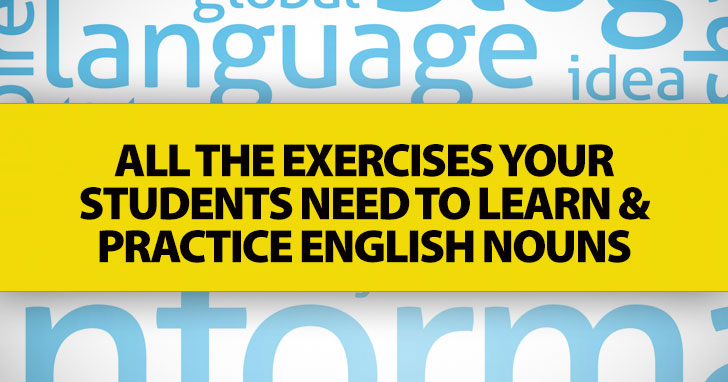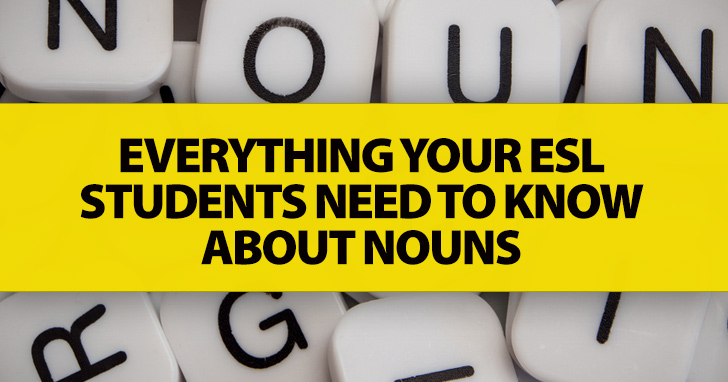All the Exercises Your Students Need To Learn and Practice English Nouns


The English language contains more nouns than any other type of word. Without nouns, we couldn’t talk about the things around us. We couldn’t form sentences and share ideas. We couldn’t communicate at all. In ESL classes, nouns are one of the first things students learn about. But these language building blocks are so important, so common, it’s easy to overlook one of their facets. Everything about them seems so second nature. Life is made up of nouns, but what do ESL students have to cover in a class on nouns that they don’t already know? Read on for the answer.

You probably learned the answer in first grade. Nouns are words for persons, places, or things. Nouns that name things include the things we can see around us as well as ones we can’t, like ideas and concepts. Nouns that we can see are considered concrete nouns. Those that refer to ideas, feelings, and emotions as well as nouns that a person cannot see or touch are referred to as abstract nouns. Nouns include proper nouns, specific nouns referring to specific people or places, which start with a capital letter. For example, Paris is one specific city in one specific location. It cannot refer to any city in any location. Nouns also include common nouns, general words which refer to any one noun of a particular category. For example, boy can refer to any male child under a certain age.
Nouns have specific functions in a sentence. If they are the perpetrators of the action in a sentence (the verb), they are the subject of the sentence. If they come after the verb and are the receiver of the action, they are objects of the verb (also called the predicate noun). They can also serve the role of indirect object in a sentence. They might also follow a preposition to complete a prepositional phrase in which case they are the object of the preposition. Sometimes they fill the less common roles of object compliment, predicate nomative, and the noun in an appositive, but your students won’t have to know about those functions until they are more advanced in their English studies.
A singular noun refers to one of something. A plural noun refers to more than one of something. In English, nouns are generally made plural by adding –s to the end of a noun: dog/dogs, house/houses, boy/boys. Nouns which end in –s, -ch, -sh, -x, or –z are made plural by adding –es: witch/witches, box/boxes, pass/passes. Nouns that end in –y can follow one of two patterns. If the letter before –y is a vowel, add –s to make the noun plural: boy/boys, tray/trays. If the letter before –y is a consonant, change –y to –i and add –es to make the noun plural: baby/babies, sky/skies. In addition, English includes countless irregular plurals, which ESL students will have to memorize: man/men, child/children, and fish/fish, for example.
One type of noun that can be confusing to ESL students is collective nouns. These are singular nouns which refer to several members of one body. For example, crowd is a singular noun, but it refers to many people gathered together. Another example of a collective noun is a school of fish. The school contains many fish, but the word itself is singular. Collective nouns take singular verbs. The school swims. The crowd roars. Be sure your students understand what a collective noun is and why it takes a singular verb. Other collective nouns include bunch, set, bouquet, audience, jury, family, flock, herd, and team, though there are many more than these in the English language.
Another type of noun which can be confusing for ESL students who are learning about singular and plural nouns is noncount nouns. Noncount nouns are those which cannot be counted without the addition of a quantifier. For example, rice is a noncount noun. It cannot be made singular or plural without another word to modify it.
In the above sentence, grain serves as a quantifier for rice. It allows you to communicate a specific number of that object. Other noncount nouns include (pieces of) homework, (pieces of) furniture, (cups of) milk, coffee, and tea.
Some ESL students may become confused with possessive nouns. These nouns take ‘s at the end of the word. They do this to indicate possession.
In the above sentence, the ‘s at the end of the word boy indicates that the car belongs to the boy, and only that one boy. Plural nouns can also be made possessive. If a plural noun (or any noun for that matter) already ends in –s, simply add an apostrophe to make the noun possessive: the boys’ cars, Chris’ book, etc.
Generally, English nouns do not have gender (unlike those in the native languages of many ESL students). For example, book is considered “it” rather than he or she. Some nouns in English do carry the idea of gender, but often they have two versions each of which refers to either a man or a woman: waiter/waitress, actor/actress, etc. One exception to the lack of gender rule is cars, boats, and other vehicles, which are sometimes referred to in the feminine sense. E.g. My boat is on the water, and she is beautiful.
Nouns are common, they are basic, and they can still be confusing for some ESL students. If you go through these different points in regards to nouns, your students will have a good foundation on which to build the rest of their English studies.
How do you teach that point in a way that helps them be successful?